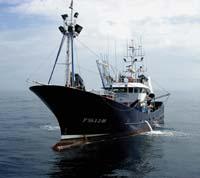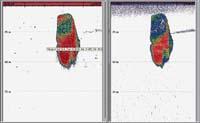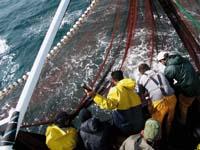Anchovy in search of young people

AZTI-Tecnalia developed the scientific campaign JUVENA06 in September and October 2006. The results of this campaign indicate that the number of anchovies born last spring was insufficient to stimulate the population. Therefore, anchovy fishing continues in danger.
Since 2003, annual JUVENA campaigns have been carried out in early autumn with the aim of measuring the population of juvenile anchovy in the Bay of Biscay. They are acoustic campaigns, that is, they calculate the number of anchovy juveniles by acoustic probes or echoprobes.
The autumn campaign was carried out with two boats: Emma Bardan with oceanographic boat and the fishing boat Itsas Lagunak. Both containers were equipped with scientific echoprobes. The first fishing with pelagic trawling nets and the second, as fishermen of the Cantabrian, with fence net.
These two boats have analyzed the presence of juveniles throughout the gulf. Sampling is done taking into account the expectations of juveniles of anchovy at this time and trying to locate the western and northern limits of the distribution surface. According to previous studies, at this time the young anchovies move from the oceanic part of the gulf to the coast, crossing the continental slope to the Cantabrian and French coasts.
Exploring the Gulf
Sampling is done in transsections perpendicular to the coasts. Among the traffics there are 15 nautical miles that extend to a minimum depth point of 2.000 m. At this point, if the presence of anchovy is still detected, progress continues to reach 3 nautical miles without anchovy.

The acoustic energy detected by Ekozundek is visualized through ecosystems. The images that are formed in these ecograms are called ecoutenskills, and depending on their shape or structure you can differentiate the energy that corresponds to the fish. Subsequently, from the information obtained from the fisheries carried out, it is calculated to what species and to what extent this energy corresponds.
In each transept, when the first ecoutenskills appear, a vote is made and from there, whenever a change in the structure of the ecotasks is observed, fishing is again. Catches are classified by species and specimens of a random sample of each species are measured. In the case of anchovy, the sample is frozen and then, in the laboratory, the age is weighed and calculated.
Sampling is done during the day or at most for a couple of hours after dusk. In fact, young anchovies appear to form dense banks throughout the day, but at night they disperse and are difficult to identify between the layers of plankton.
According to the results of the campaign, in autumn 2006 the distribution of anchovy juveniles was very expensive. Much of the population was found in waters less than 50 m deep, especially south of the gulf. In previous years the southern anchovies appeared around the slope. In Iparralde, on the contrary, the distribution was wider and mixed with adult anchovy. In terms of quantity, anchovy fell by 50% compared to 2005 and 30% less than in 2003.
The ultimate goal of JUVENA campaigns is to establish a relationship between the abundance index of anchovy juveniles and the abundance of adults the following year. At the moment, there are only three points of this relationship: Autumn-Spring 2003, Autumn-2004 Spring 2005 and Autumn-2005 Spring 2006 The next point will be established after the spring campaign of 2007, but for the moment the series is too short to make predictions and only has guiding value.
Key in management

Knowledge of anchovy biology indicates that it is a very vulnerable species and that it has large fluctuations from year to year, due to its short life (3 years), its high mortality (both natural and fishing) and the large dependence of adult biomass on the abundance of new generations, which can cause serious resource crises. According to the researchers of Azti-Tecnalia, to ensure the recovery of anchovy, administrations and the sector itself must work on an adequate management based on scientific criteria.
Although the data of the JUVENA campaign have only a guiding value, they ratify the recommendation issued by the Council of Scientists for Marine Research (ICES) and approved by the scientific, technical and economic committee on fisheries of the European Commission (STECF). According to this recommendation, it is advisable to prohibit fishing until confirming the recruitment necessary to stimulate the biomass of breeders.
However, the Council of European Ministers did not adopt any decision to ban anchovy fishing in December 2006, but proposed experimental fishing. That is, 8 French and 20 Cantabrian fishing boats, accompanied by scientists, will go fishing next spring.





